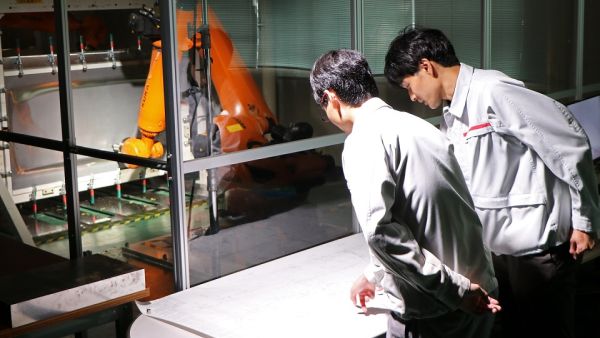Nissan Teaches Robots to Make Replacement Parts for Cars

Nissan has developed a new way to use robots to make car parts out of sheet steel, a breakthrough that could make replacement parts for discontinued models more widely available for customers.
Nissan hopes to commercialize the proprietary technique, known as dual-sided dieless forming. The technique involves two synchronized robots working from opposite sides of a steel sheet, using diamond-coated tools to gradually shape the steel.
Thanks to its flexible production, short lead times and minimal upfront costs, the new technique could make it commercially viable to produce and sell a wide variety of after- service and replacement parts in small volumes for cars that Nissan no longer makes. This was previously not possible due to the high upfront costs and long lead times to develop and make dies for stamped parts.
Until now, dual-sided dieless forming had been considered too difficult to commercialize. This was due to the complexity of programming two robots to operate synchronously while ensuring consistent quality. Existing techniques have primarily relied on single-sided forming, which limits the complexity of shapes that can be created. By placing robots and tools on opposite sides of a steel sheet, they can create more difficult and detailed shapes.
The new technique was made possible thanks to the production engineering expertise at Nissan’s Production Engineering Research and Development Center, along with advancements in materials technology by Nissan’s Research Division. It represents three major breakthroughs:
The development of advanced programs capable of controlling both robots with a high degree of dimensional accuracy, enabling the formation of detailed convex and concave shapes.
The application of a mirrored diamond coating to tools, reducing friction while eliminating the need for lubrication. This has numerous benefits, including consistency of surface quality and low-cost, environmentally friendly operation.
The generation of optimized pathfinding logic for robots, drawing on the ample expertise and press-forming simulation techniques ordinarily used by Nissan’s production engineering teams. This enabled Nissan to achieve high quality results early in the development process.
Nissan plans to continue pursuing advancements in mass production while also dedicating
R&D resources to honing its flexible low-volume production techniques.
Background Information
Nissan Middle East
Nissan’s heritage in the Middle East goes way back to 1957, when the first Nissan vehicle was sold in Saudi Arabia. Since then the Nissan Legacy has taken deep roots in the hearts of the Middle East people by becoming an integral part of their lives.
Currently Nissan is one of the most popular and successful automobile brands in the Middle East boasting of a strong line-up ranging from popular passenger cars to powerful 4x4 series and commercial vehicles.
In its quest to closely understand the local needs of its customers, Nissan Motor Co. Ltd. in June, 1994 set up a regional Middle East head quarters in Dubai, thus becoming the first Japanese car manufacturer to accomplish this feat. The Nissan Middle East FZE office houses a highly sophisticated training center which serves as an excellent training ground for undertaking Nissan customer care and service activities.






